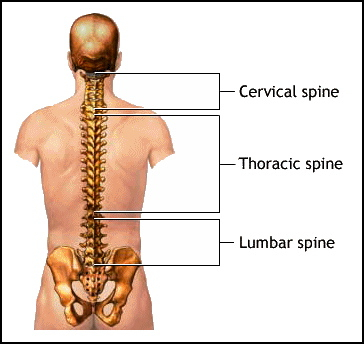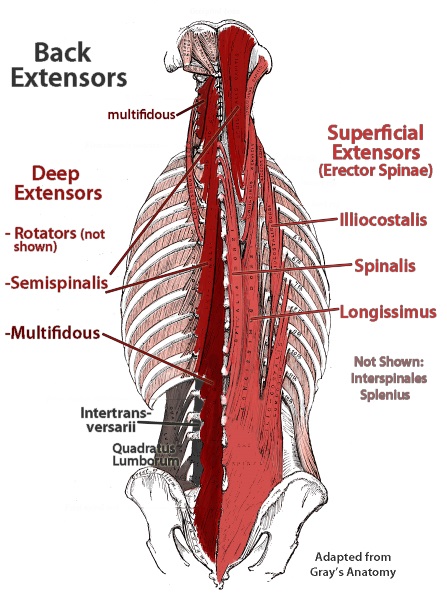What is upper and middle back pain?
Upper and middle back pain can occur anywhere from the base of your neck to the bottom of your rib cage. Your ribs attach to a long, flat bone in the center of the chest called the sternum and attach to and wrap around your back. If a nerve in this area is pinched, irritated, or injured, you may also feel pain in other places where the nerve travels, such as your arms, legs, chest, and belly.
The upper and middle back (called the thoracic spine) has:
- 12 vertebrae. These bones attach to your rib cage. They make up the longest part of your back.
- Discs that separate each vertebra and absorb shock as you move.
- Muscles and ligaments that hold the spine together.

Upper and middle back pain is not as common as low back pain or neck pain, because the bones in this area of the back don’t flex or move as much as the bones in your lower back or neck. Instead, they work with the ribs to keep the back stable and help protect vital organs, such as the heart and lungs.
Extensor, Flexor and Oblique Muscles and Back Pain
Three types of back muscles that help the spine function are extensors, flexors and obliques.
- The extensor muscles are attached to the posterior (back) of the spine and enable standing and lifting objects. These muscles include the large paired muscles in the lower back (erector spinae), which help hold up the spine, and gluteal muscles.
- The flexor muscles are attached to the anterior (front) of the spine (which includes the abdominal muscles) and enable flexing, bending forward, lifting, and arching the lower back.
- The oblique muscles are attached to the sides of the spine and help rotate the spine and maintain proper posture.
Facts about Mid Back Pain
A review found the range of prevalence estimates of thoracic back pain in the general population to be very broad because of many factors, including the different definitions and duration of thoracic back pain included. The results of the review were as follows:
- Prevalence data ranged from 4.0-72.0% (at any one time), 0.5-51.4% (seven-day), 1.4-34.8% (one-month), 4.8-7.0% (three-month), 3.5-34.8% (one-year) and 15.6-19.5% (lifetime).
- Studies reported a higher prevalence for thoracic back pain in children and adolescents, especially for females.
- In children and adolescents, thoracic back pain was associated with female gender, postural changes associated with backpack use, backpack weight, other musculoskeletal symptoms, participation in specific sports, chair height at school and difficulty with homework. Poorer mental health and age transition from early to late adolescence were also significant risk factors.
- In adults, thoracic back pain was associated with concurrent other musculoskeletal symptoms and difficulty in performing activities of daily living.
What causes upper and middle back pain?
- Thoracic back pain can occur as a result of trauma or sudden injury, or it can occur through strain or poor posture over time.
- The most common cause of thoracic back pain appears to originate from muscular irritation or other soft tissue problems. These can arise from lack of strength, poor posture, prolonged sitting at a computer, using a backpack, overuse injuries (such as repetitive motion), or trauma (such as a whiplash injury caused by a car accident or as a result of a sports injury).
- The thoracic spine is a relatively common site for inflammatory, degenerative, metabolic, infective and neoplastic conditions.
- Thoracic back pain and dysfunction are associated with conditions such as primary and secondary osteoporosis (especially vertebral fractures and hyperkyphosis arising from vertebral bone loss), ankylosing spondylitis, osteoarthritis and Scheuermann’s disease.
In rare cases, pain may be caused by other problems, such as gallbladder disease, cancer, or an infection.
What are the symptoms?
Common symptoms of upper and middle back pain are:
- A dull, burning, or sharp pain.
- Muscle tightness or stiffness.
More serious symptoms that need to be treated right away include:
- Weakness in your arms or legs.
- Numbness or tingling in your arms, legs, chest, or belly.
- Loss of bowel or bladder control.
How is upper and middle back pain diagnosed?
Your doctor will first ask you about your past health, your symptoms, and your work and physical activities. Then he or she will do a physical exam. Your doctor may also order an imaging test, such as an X-ray or an MRI, to find out if something such as a broken bone or a herniated disc is causing your pain.
You may need more tests to check for other possible causes for your pain.
How can you care for yourself at home?
There are several things you can do at home to help reduce your pain. For example:
- Rest. If your back hurts a lot, take a break. But try not to let too much time pass before you get moving again. Instead, return to your activities slowly.
- Use over-the-counter pain medicines, such as acetaminophen (for example, Tylenol) and nonsteroidal anti-inflammatory drugs (for example, Advil, Aleve, aspirin, and Motrin). These can reduce pain and swelling. Be safe with medicines. Read and follow all instructions on the label.
- Use a heating pad or ice pack. Heat can reduce pain and stiffness. Ice can help reduce pain and swelling.
- Practice good posture. Be sure to stand or sit tall. Don’t slump or slouch.
- Learn ways to reduce stress. You might try deep breathing and relaxation exercises or meditation.
- Exercise. Exercises that stretch and strengthen the muscles in your back, shoulders, and stomach can help improve your posture, decrease your chance of injury, and reduce pain.
Quick Stretches To Alleviate Mid Back Pain
1. Cat-Cow Movements
These gentle spinal movements are an excellent way to warm the body up for more difficult postures while releasing stiffness in the mid back.
- Start on all fours with the wrists directly under the shoulders and knees under hips. Feel free to rest your knees on a blanket if you feel discomfort.
- Spread the fingers wide and distribute weight evenly throughout the hand. Press your palms and finger pads into the ground to avoid dumping weight into the wrist.
- Inhale, gently sending the pelvis upward and the heart forward, dipping the belly down and your face up.
- Exhale, arch the back like a cat, rounding the spine, tucking the pelvis, and letting the head hang loose.
- Repeat five to seven times, feeling your spine begin to open, allowing the stretch to deepen as you warm up.
2. Passive Back Bend
After a long day at work, a passive backbend can help relieve tension. Hold this pose for as long as you like, preferably for at least three minutes. Incorporating this stretch into your daily routine will dramatically increase back flexibility, reduce tension, and improve your posture.
This variation uses props you can find at home, but feel free to use yoga blocks if you have them.
- Roll up a blanket, towel, or yoga mat. Place the roll on the floor. If using a yoga mat, you may want to roll only part of it, depending on your back flexibility and the mat’s thickness. A bigger roll requires more flexibility while a smaller one offers a more gentle release.
- Lie on the roll so it rests against the bottom of the shoulder blades, close to the middle of your back. If you’d like to use yoga blocks for a deeper version of this backbend, place one block under the shoulders and a second under the head. Elevate the head as much as necessary so the neck feels supported.
- Relax into the posture, placing a second blanket under the head as a pillow if necessary. Keep the breath long and deep.
3. Cobra Pose
This gentle backbend both stretches and strengthens the back.
It can be tempting to use the arm muscles to access a deeper backbend, but focusing on engaging the back muscles is a more effective way to release back tension and build muscle to improve posture. Improved posture will help tension from accumulating in the back.
- Lie on your stomach, body long, chin on the mat or face down. Place the hands underneath the shoulders.
- Inhale and curl the chest off the ground, engaging the back muscles. You might even lift the hands up off the ground for a moment to test how much you’re engaging through the back.
- Press lightly into the hands to deepen the stretch. About 95 percent of the bend should come from the back, with just a little extra push coming from the hands.
- Hold for two breaths and release. Repeat two more times.



